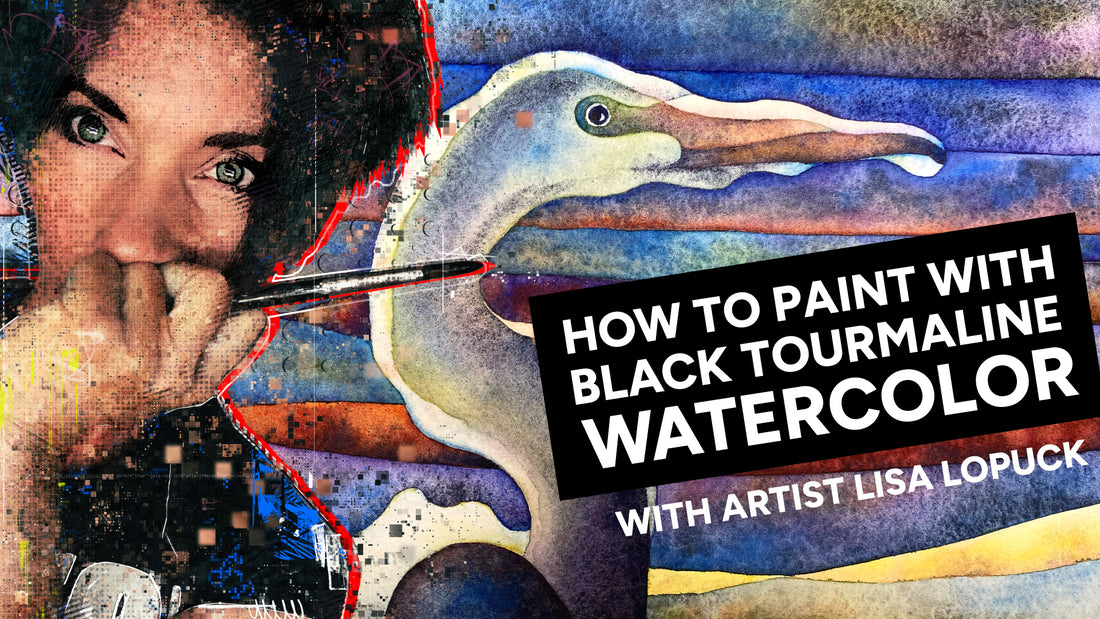Learn watercolor painting tips and techniques with artist Lisa Lopuck
Lisa is a signature member of the National Watercolor Association (NWA), and has been using watercolor for over 20 years. In this video, Lisa shows tips for painting with watercolor, and the unique benefits of painting with mineral based paints like her homemade black tourmaline watercolor paint. These paints, when combined with other watercolor, create incredible granulating texture effects, taking your art to a whole new level.
Purchase black tourmaline watercolor paint
Tips for how to paint with watercolor
Use Only High Quality Paper
Always use high quality 100% rag watercolor paper such as Arches brand. Cheap watercolor paper cannot hold enough water to give you a nice working canvas and you'll be fighting for a good result.
The water is your canvas
It may sound counterintuitive to not think of the paper as your canvas as it is with other media like acrylic, but in watercolor, the water you lay down is in fact the canvas you have to work with. This is why working only with good paper is critical. Once you learn how to control the level of wetness on your paper, you can better predict and "coach" the interactions of watercolor within an area.
Combine mineral-based paint with standard color
A few watercolor brands such as Daniel Smith (among my favorite) have an extensive catalog of granulating mineral-based paint that produce amazing leather-like textures. There are also several homemade options on Etsy, and with my own hand crafted small batch black tourmaline watercolor paint that are of an even higher quality. Using these mineral paints in combination with standard colors lets you achieve an incredible level of depth in your artwork.
“Coaching” watercolor, not controlling
So many people want to “control” watercolor and become frustrated at how hard that is to do. Instead, think of yourself as a watercolor “coach.” You can influence the result by 1) understanding how different paints interact (which takes time and trial and error), and 2) by controlling the wet area and its level of wetness.
So, the first secret to painting with watercolor is to wet only the area you want to work in. Easy enough! Watercolor paint can only spread and get unruly where it's wet. For some artists, this means wetting the entire paper and laying down washes of paint. For me, it means working on one area, or shape, at a time.
Once the area is wet, the trick is to use a brush to drop paint onto the water. That can be done with a gentle guided brush stroke over the wet area or simply dabbing paint in. Either way, the paint will immediately start to spread out within the wet area. Don't press hard with the brush - let the wet area pull the paint from the brush. If you push, you are scrapping the paint directly onto the paper surface—losing any innate magic or transparency of watercolor paint.
Watercolor paint will spread out and interact with neighboring colors according to the level of wetness. If an area has a ton of water, you'll get a high degree of inter mixing of neighboring colors—perhaps too much. If the paper is only damp, the paint more or less stays put and only superficially interacts with its neighboring colors. So, by controlling the level of wetness in an area, you can influence, or “coach,” what the paint does.
How do you control the level of wetness? You can use your brush as a sponge. If an area gets too wet, use a semi-dry and clean brush as a sponge to pull water out. I typically work with a paper towel in one hand and my brush in the other so I can quickly dry off my brush and pull more water out as needed.
Avoid pushing hard with your brush
What you DON'T want to do is push hard, scrub, or add paint to a dry area. Watercolor wants water to do its magic. Therefore, use the brush to apply paint to wet areas, and use it as a sponge to both add more water for the paint to really interact together, or to remove excess water to reduce the amount of inter-paint interaction.
